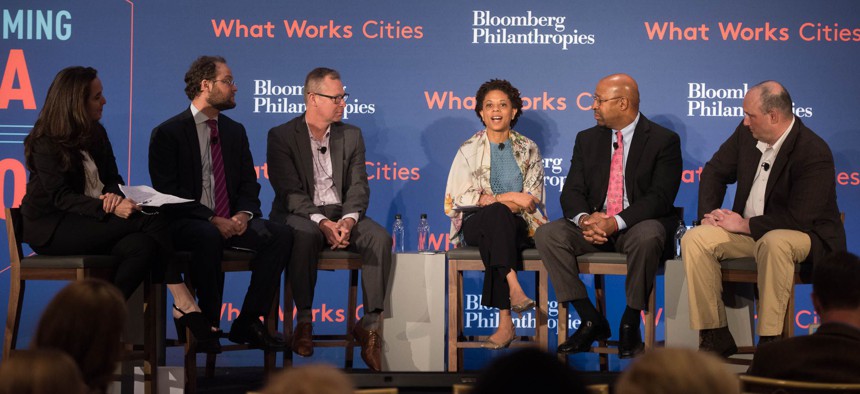Making Data-Driven Government Fundamental and Sustainable in City Halls

A panel discussion at What Works Cities summit in New York City on Tuesday. Photo by Craig Warga via What Works Cities
As the What Works Cities program, funded by the Bloomberg Philanthropies, celebrates its first year, municipal leaders and experts are looking at ways to make the results of their data efforts “so essential that nobody can take it away.”
NEW YORK — A shift in mayoral administrations can sometimes shift city hall priorities. A new mayor can let a predecessor’s initiatives stagnate, whither on the vine or kill them off altogether. Or they can build upon them and make them better. It’s their prerogative either way.
So with municipal data initiatives—like launching an open data program or implementing analytics programs for performance management—how can one mayor ensure that investments in time, agency energy and local government resources live on under future administrations?
According to former Philadelphia Mayor Michael Nutter, sometimes you just have to make a program “so essential that nobody can take it away.”
That’s a lesson Nutter said he first learned in 2007 from former New York City Mayor Michael Bloomberg, who had invited then-Councilmember Nutter, fresh off winning Philadelphia’s Democratic mayoral primary and poised to triumph in the general election, up to New York City Hall to better understand the fundamentals of Bloomberg’s data-driven government.
“If you want sustainability for your ideas, make them so good and … essential that nobody can take them away,” Nutter said this week during a breakout session at the first What Works Cities summit, hosted by the Bloomberg Philanthropies at the Lotte New York Palace Hotel in midtown Manhattan.
Developing sustainable practices for data-driven government, the ones future mayors would hopefully maintain and develop, was a common thread of discussion at the summit,
On Tuesday, former New York City Mayor Michael Bloomberg welcomed the approximately 200 What Works Cities participants to his city, where he served three terms in office. While there’s a new mayoral administration at New York City Hall, Bloomberg’s interest in the nuts and bolts of how municipal governments operate continues, but the scope has shifted to the rest of the nation.
A year ago, the Bloomberg Philanthropies announced a three-year, $42 million investment to launch What Works Cities, which aims to help 100 mid-sized U.S. cities better leverage their data resources by pairing them with experts from the program’s partner organizations: Results for America, the Center for Government Excellence at Johns Hopkins University, the Government Performance Lab at Harvard University’s Kennedy School of Government, the Sunlight Foundation and the Behavioral Insights Team.

There are currently 27 participating What Works Cities with 30 more being added to the program by the end of 2016. To date, the What Works Cities program has worked with 1,000 city leaders and conducted 60 diagnostic exercises with municipal governments.
And “the results are piling up,” James Anderson, who leads public sector innovation programs at the Bloomberg Philanthropies, said during welcoming remarks.
While the participating cities are gaining access to resources and expertise, they’re also learning from one another.
“Copy other people’s ideas,” Bloomberg urged the 200 mayors, municipal leaders and What Works Cities partners. “Who cares where they come from?”
After all, Bloomberg said, “cities have a lot more in common than they have differences.”
That concept—sharing ideas and insights across jurisdictional boundaries—was repeated by many of the mayors and experts at the summit.
“A great idea is a great idea, regardless of where it came from,” Nutter, who is a senior fellow with What Works Cities, said during a breakout session about the “Roadmap to Sustainability.”
But how does a city implement those great ideas? And how does a municipal government shift its outlook and operations when it comes to data?
“This is about leadership and it’s not just about the mayor,” Nutter said, stressing there has to be “buy in” from agency leaders, managers and other city hall and municipal agency staffers.
In a recent interview with Route Fifty, Mike Flowers, who served as Bloomberg’s first chief analytics officer at City Hall and is a What Works Cities senior fellow, noted that something like implementing a data analytics and performance management program can necessitate city leaders and agency managers to press for operational culture change.
It should be collaborative, not disruptive. “. . . [Y]ou have to make sure you are measuring the right thing and those metrics need to be constantly looked at and perhaps tweaked and revised to make sure that the end game is not lost,” he said.
Implementing a framework for data-driven government in a city hall doesn’t always lead to definitive answers for some of the toughest challenges. But it provides a path forward.
“It makes you ask other questions,” Marilyn Strickland, the mayor of Tacoma, Washington, told Route Fifty in an interview.
For instance, in Strickland’s city, which anchors the south Puget Sound region near Seattle, examination of data has helped leaders better understand the resources available for homeless services in Tacoma and in neighboring local jurisdictions. And having the data as a foundation will better inform leaders in and around Tacoma about how resources could be delivered more effectively.
And while municipal governments face the same types of challenges, those challenges manifest themselves in different ways. “Every city is different” and has “its own rhythm,” Flowers said. “The trick really is to respect those cultural idiosyncrasies.”
Much of the discussion around data in local government in recent years has focused on talking up the potential of effective data strategies to transform government operations and on the deployment of open data programs that makes government data more transparent for citizens and stakeholders while giving civic tech developers a treasure trove of public information to build new apps, information tools and other resources.
Kevin Merritt, the founder and CEO of Seattle-based cloud software company Socrata, told the What Works Cities summit participants that “. . . it feels like we’re exiting this age of evangelization of data-driven government,” and are now getting into the nuts and bolts of taking that data to improve operations.
“We’ve been focused on the external benefits,” Merritt said. But when it comes down to the fundamentals of leveraging data in municipal operations, “it really needs to make the jobs of government workers better.”
There’s a lot of work to be done in What Works Cities’ second year. But the work is certainly worthwhile and won’t just help the individual What Works Cities with their respective data challenges in the near term. It will eventually help all municipal governments by showing what works, what doesn’t and why.
And those are insights that not only will make sound municipal data strategies fundamental for a city government’s success but also sustainable for the long haul.
Michael Grass is Executive Editor of Government Executive’s Route Fifty.
NEXT STORY: As driverless cars hit the streets, states weigh new rules






